The Garden City Movement was invented by Sir Ebenezer Howard (1850-1928) (Couch, 2014). It was first described in his book Garden Cities of Tomorrow, published in 1902 (Ebenezer Howard, 2014). The Garden City Model introduced the application of some basic planning rules that are still in use today. It consists of self-sufficient communities surrounded by greenways with planned proportional countries in agriculture, housing, commerce, and industry (Audiopedia, 2014). This essay discusses the creation and development of the theoretical and planning principles of the Garden City Model and its success in solving the economic and social problems of densely populated cities in the UK. It also discusses the modification of these rules and their applications in modern planning theories.
The search for an ideal city was due to the intense industrialization and resulting urbanization of major UK cities around the late 19th century. There were many social, economic, and commercial activities in big cities, thereby causing high levels of migration from less developed parts in the UK towards these cities. This excessive migration resulted in issues such as overpopulation, housing deficit, high rents, air pollution, urban slums, and lack of sunshine and open spaces (Howard, 1902). According to Fishman (1982), Howard perceived the economy to be corrupt, inhumane, inefficient, and unhealthy (see Fig 1, 2).
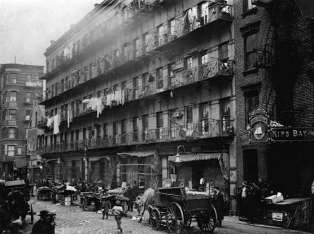
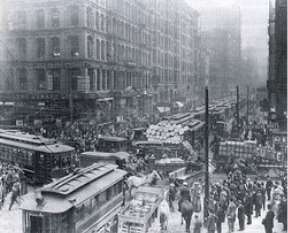
Fig. 1 Hine (1912); Fig. 2 Industrial Cities (n.d.)
Analyzing the issues developed by rapid urbanization, Howard noticed a contrasting phenomenon in the countryside. The countryside suffered from depopulation, a deficiency of amusement, society, capital, and labor.
The town had all that the country was missing and vice versa. Howard sought to unite the best aspects of the town and the country in the formation of garden city (Ebenezer Howard, 2014).
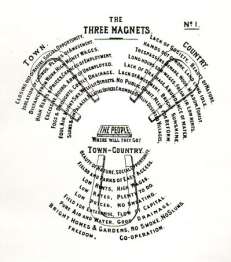
Fig. 3 The Three Magnets (1902)
Redefining the town and countryside as magnets, the people as needles, and man’s socioeconomic desires as attractions, Howard developed the theory of The Three Magnets, presenting the third option: the Town-Country Magnet (Howard, 1902). The Town-Country offers high rewards, social opportunities, places of amusement, healthy living conditions, low rents, and large parks (Howard, 1902). Howard believed that the Town-Country would enhance the enjoyment of human society and the beauty of nature simultaneously (Fishman, 1982).
To achieve the socio-economic aspects of the Town-Country, the ideal city would operate through communal land ownership, whereby rent would be the main source of revenue employed by the municipality (regulating body) in the creation and maintenance of public amenities, old age pensions, and accident insurance (Howard, 1902). The Garden City was to be built from scratch on agricultural land, which had low ecological value, thereby increasing the value of the land so that it could generate significant revenue through rent for the municipality (Howard, 1902).


Fig. 4 Garden-City (1902); Fig. 5 Ward and Centre Garden-City (1902). The spatial program of a sector of the city.


Although the Garden City Model is really descriptive, it is not a morphological but instead a socio-economic illustration of principles (Butcher, 2010). Planned in a concentric form, with six radial avenues, on a site of 6,000 acres, Garden City would have a population of 32,000 people (Audiopedia, 2014). In the center of the city lies a public garden, surrounded by public buildings which include a hospital, library, museum, art gallery, town hall, concert hall, and theater (John, 2014). The surrounding area is the central park for recreational activities. These large parks are more of a rural feature, but they work much better in the urban context because of the increased population. Beyond the central park is the crystal castle, a round glass arcade for commercial activities (John, 2014).
The placement of the crystal castle beside the central park shows Howard’s intention to connect human activities with nature. Before the introduction of Howard’s principles, commercial zones in cities rarely had parks and open spaces due to the high value of the land. Nowadays, having open spaces in commercial areas is a common planning practice. Beyond the crystal, castle is houses with tree-lined streets, additional parks occupied by public schools, recreational areas, and churches (John, 2014). On the outskirts of the city are industries with direct access to the railroad, saving costs of packaging and transportation of goods from the train to and from factories (John, 2014). The rest of the land beyond the railroad is used as agricultural land held by various individuals and organizations and provides alternative farm job opportunities to the working class without isolating them from the city (Howard, 1902). This agricultural land also serves as a barrier to urban sprawl, as it cannot be built on. As shown in Figure 6, the use of green belts to control urban sprawl is still evident in UK cities today.

Fig. 7: Group of Slumless Smokeless Cities (1902).
Recognizing the fact that urbanization is bound to increase due to its socio-economic benefits, Howard envisioned a series of garden cities, separated by green belts and connected by roads and railways, with the central city having a population of 58,000 (see Fig. 7). The introduction of these cities also aims to control excessive migration to cities with more attractions.
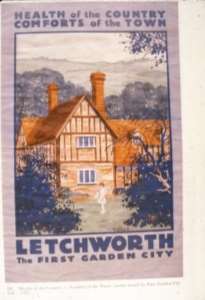
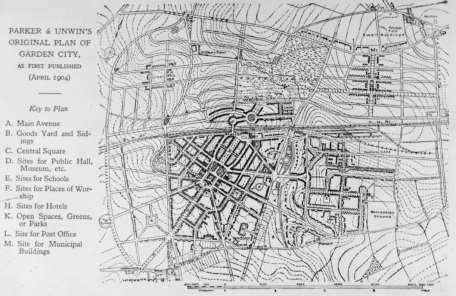
Fig. 8: Letchworth-1925 Poster (n.d.); Fig. 9: Original Program of First Garden City, Letchworth 1904 (n.d.)
Ebenezer Howard’s Garden City model directly experimented on two towns: Letchworth and Welwyn Garden City. Letchworth was the first Garden City ever built (Ebenezer Howard, 2014). It is located in Hertfordshire, England, 35 miles from London, and covers an area of 5,500 acres, which used to serve as agricultural land with little or no value (Ebenezer Howard, 2014). Although Letchworth was not designed in a regular concentric form, it follows the zoning principles of the Garden City model.
In order to build Letchworth, Howard needed support, but he did not receive any financial assistance from the government. I suppose this was because the development of his ideal city had no positive effect on the preexisting cities, which had already been heavily invested in. The idea of destroying or ignoring existing cities to rebuild perfect ones was also the basis of many other revolutionaries attempting to solve the industrial crisis. This approach displays a lack of consideration for the financial needs involved in the realization of ideal cities. According to Audiopedia (2014), Howard received financial support only from private investors who were concerned with their personal profits, rather than the communal growth of Letchworth City. As a result, Howard forwent the idea of communal land ownership without landlords (Audiopedia, 2014).
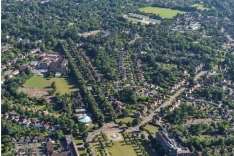

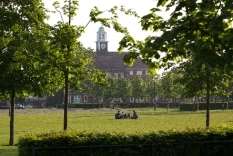
Fig. 9 Aerial photograph of Letchworth Garden City (n.d.) Fig. 10 Howard Park (n.d.) Fig. 11 Broadway Gardens (n.d.)
Letchworth was environmentally successful, with lots of open spaces and public parks, healthy living conditions, and beautiful tree-lined streets, most of which remain today (Letchworth Garden City Heritage Foundation, 2014). The city attracted residents because of the cheap rent and extra space resulting from its earlier use as agricultural land. It also attracted businesses because of the favorable living conditions. However, due to the fact that communal land ownership was ignored, the rents were not affordable and could only be afforded by skilled white-collar workers (Audiopedia, 2014). Letchworth failed partly as an independent community because of the improved transportation system, which made it easier to connect to London. Welwyn, the second Garden City located 20 miles from London, performed just as well as Letchworth but lacked public, commercial, and industrial buildings, causing it to heavily depend on London for socio-economic activities.
Due to the physical success of Letchworth, the principles of the Garden City were applied to various developments worldwide, and in most cases, it has been misconceived as the development of suburbs. The New Towns Act of 1946, implemented by the government after World War II, was inspired by the Garden City Movement (Audiopedia, 2014). The Act involved the allocation of land for the development of garden suburbs in the UK (New Towns Act 1946, 2014). The development of new towns led to the suburbanization of cities, which was the antithesis of Howard’s theory (Audiopedia, 2014). Despite its contradiction with Howard’s theory, the new towns succeeded in offering healthy living conditions and maintaining population density, but they were not economically independent.

Fig. 12 Uxcester Garden City. (2014) Fig – new suburbs in the blue, pre-existing city in grey.
Recently, Uxcester Garden City, an imaginary city inspired by the Garden City Model, was announced as the winner of the 2014 Wolfson Economics Prize (Sweet, 2014). It was initiated as a solution to the current UK housing deficit crisis. It is a combination of the planning principles of Garden City and the suburbanization strategy of the New Towns. Unlike Garden City, it is not built from scratch, but rather gradually incorporated into pre-existing cities. The strategy involves the development of residential communities on agricultural green belts, which are currently considered to have low ecological value (Sweet, 2014).
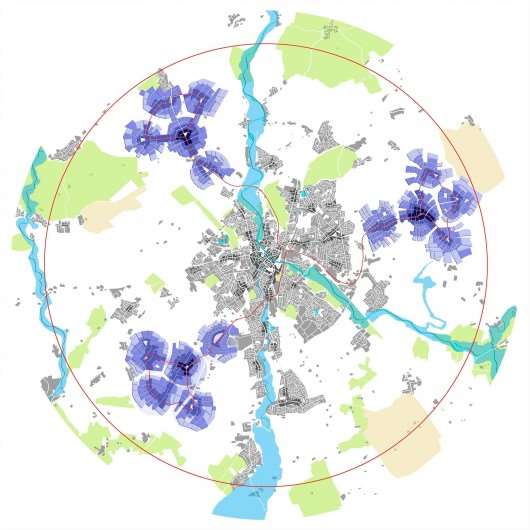
Fig. 13 Uxcester Garden City (2014). Organic representation of Uxcester.
Each community is planned to have half of its area designated for woods, public parks, and lakes (Sweet, 2014). These new residential communities will need dependable transportation systems linking them to the city center, which provides most of the social activities. On the other hand, the new suburbs will regenerate the city center by creating new demand for what is on offer there (Sweet, 2014). Although the strategy involves the suburbanization of cities, it observes the Garden City aims, which include the provision of healthy living conditions to ordinary people and socio-economic independence.
The Garden City Model inspired the New Towns Act and Uxcester Garden City. It has had a major effect on town planning, which has a direct impact on human behavior. Howard’s principles have recently been adopted in the development of the Uxcester Garden City strategy for solving the housing deficit problem the UK is facing today. Although the effect Uxcester will have on UK housing has not been decided, I think the further development of suburbs would either increase the deficiency of job opportunities or increase the volume of commercial buildings in the city center. It will then be up to designers to ensure healthy working conditions in these city centers.
References:
- Aerial exposure of Letchworth Garden City. (n.d.). [image]. Available at: https://www.letchworth.com/heritage-foundation/news-and-blog/media-enquiries [Accessed 6 Jan. 2015].
- Audiopedia. (2014). Garden City Movement. [Online Video]. 13 November. Available from: https://www.youtube.com/watch?v=I_MacpHZ-Bk. [Accessed: 03 January 2015].
- Broadway Gardens. (n.d.). [image]. Available at: https://www.letchworth.com/heritage-foundation/news-and-blog/media-enquiries [Accessed 6 Jan. 2015].
- Butcher, L., 2010. Architecture + Urbanism. [Online] Available at: http://architectureandurbanism.blogspot.co.uk/2010/10/ebenezer-howard-garden-cities-of-to.html [Accessed 01 March 2015].
- Couch, A. (2014) Arch 221 Urban Studies Week 4 Lecture: Note taking accomplishments from talks and readings, Liverpool: School of Architecture.
- Fishman, R., 1982. Urban Utopias in the Twentieth Century. Cambridge, Massachusetts: MIT Press.
- Garden-City. (1902). [image] Available at: http://longstreet.typepad.com/thesciencebookstore/2008/09/history-of-the.html [Accessed 01 January 2015].
- Group of Slumless Smokeless Cities. (1902). [image] Available at: http://socialethicsoundideasandfreedom.files.wordpress.com/2012/05/garden-city.png [Accessed 03 January 2015].
- Hawkes, J. (n.d.). Houses, Welwyn Garden City, Hertfordshire. [image] Available at: http://stock.jasonhawkes.com/media/8d181e48-3248-11e1-900f-1127b07b6f75-houses-welwyn-garden-city-hertfordshire [Accessed 06 January 2015].
- Hine, L. (1912). New York: Tenements. [image] Available at: http://www.allposters.com/-sp/New-York-Tenements-1912-Posters_i8677584_.htm [Accessed 06 January 2015].
- Howard, E., 1902. Garden Cities of Tomorrow. [ONLINE] Second Edition. S.l.: Sonnenschein & Co., Ltd. Available at: http://ebooks.adelaide.edu.au/h/howard/ebenezer/garden_cities_of_to-morrow/complete.html#chapter7 [Accessed 01 January 2015].
- Howard Park. (n.d.). [image] Available at: http://www.letchworth.com/heritage-foundation/news-and-blog/media-enquiries [Accessed 06 January 2015].
- Industrial Cities. (n.d.). [image] Available at: http://johnsonschneider.weebly.com/ [Accessed 06 January 2015].
- John W. Reps, 2014. Garden Cities Of Tomorrow. [ONLINE] Available at: http://urbanplanning.library.cornell.edu/DOCS/howard.htm [Accessed 02 January 2015].
- Letchworth-1925 Poster. (n.d.). [image] Available at: http://ocw.mit.edu/ans7870/11/11.001j/f01/lectureimages/6/image31.html [Accessed 05 January 2015].
- Letchworth Garden City Heritage Foundation, (2014). Letchworth Garden City. [online] Available at: http://www.letchworth.com/heritage-foundation/letchworth-garden-city/quick-facts [Accessed 05 January 2015].
- Louis de Soissons, Welwyn Garden City town program. (1921). [image] Available at: http://cashewnut.me.uk/WGCbooks/web-WGC-books-1975-1.php [Accessed 06 January 2015].
- Sdoutz, F. (2015). Garden Cities Howard, Unwin & Parker, Lutyens, de Soissons – Links. [online] ARCHITECTURETHEORY.NET. Available at: http://www.mediaarchitecture.at/architekturtheorie/garden_cities/2011_garden_cities_links_en.shtml [Accessed 5 Jan. 2015].
- Lucey, N. (1973). The Effect of Sir Ebenezer Howard and the Garden City Movement on Twentieth Century Town Planning. 1st ed. [ebook] Hertfordshire: Norman Lucey. Available at: http://www.rickmansworthherts.freeserve.co.uk/howard1.htm#snd [Accessed 5 Jan. 2015].
- New Towns Act 1946. (2014). Wikipedia. [online] Available at: http://en.wikipedia.org/w/index.php?title=New_Towns_Act_1946&oldid=621188191 [Accessed 6 Jan. 2015].
- Sdoutz, F. (2015). Garden Cities Howard, Unwin & Parker, Lutyens, de Soissons – Links. [online] ARCHITECTURETHEORY.NET. Available at: http://www.mediaarchitecture.at/architekturtheorie/garden_cities/2011_garden_cities_links_en.shtml [Accessed 5 Jan. 2015].
- Sweet, R. (2014). Welcome to Uxcester, the fanciful city that has British designers in a flap. Global Construction Review. [online] Available at: http://www.globalconreview.com/sectors/welcome-uxcester-imaginary-city-has36392725british/ [Accessed 6 Jan. 2015].
- The Three Magnets. (1902). [image] Available at: http://longstreet.typepad.com/thesciencebookstore/2008/09/history-of-the.html [Accessed 1 Jan. 2015].
- UK Green Belts. (2014). [image] Available at: http://www.estatesgazette.com/blogs/london-residential-research/2014/02/green-belt-fit-21st-century/ [Accessed 6 Jan. 2015].
- Uxcester Garden City. (2014). [image] Available at: http://www.archdaily.com/545656/urbed-s-bold-proposal-to-reinvigorate-the-garden-city-movement/ [Accessed 6 Jan. 2015].
- The original plan of first Garden City, Letchworth 1904. (n.d.). [image] Available at: http://lunaprod.library.cornell.edu/images/RMC/Size4/RMC0129/RMC2011_0602.jpg?userid=10&username=administrator&resolution=4&servertype=JVA&cid=10&iid=CORNELL&vcid=NA&usergroup=Faculty&profileid=2 [Accessed 5 Jan. 2015].
- Ward and Centre Garden-City. (1902). [image] Available at: http://longstreet.typepad.com/thesciencebookstore/2008/09/history-of-the.html [Accessed 2 Jan. 2015].
- Ebenezer Howard. (2014). Wikipedia. [online] Available at: http://en.wikipedia.org/wiki/Ebenezer_Howard [Accessed 5 Jan. 2015].
- Welwyn Garden City. (2014). Wikipedia. [online] Available at: http://en.wikipedia.org/wiki/Welwyn_Garden_City





